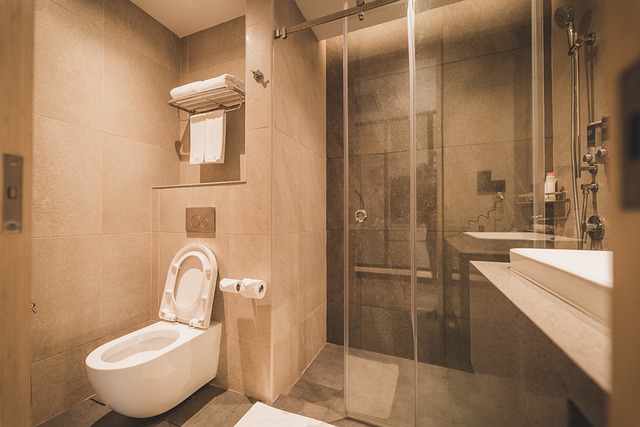
In the bustling realm of commercial restrooms, the unwelcome guests known as hard water stains often mar the pristine surfaces. These stubborn stains, caused by mineral deposits in water, can turn restroom fixtures into an unsightly sight. This comprehensive guide unravels the nuances of hard water stain removal in commercial restrooms, delving into the reasons behind these stains, the challenges they pose, and the effective strategies for restoring restroom fixtures to their sparkling best. From understanding the science of hard water stains to exploring practical and eco-friendly removal methods, this article equips restroom managers and cleaning professionals with the knowledge needed to combat the relentless battle against unsightly deposits.
Commercial restrooms, frequented by a multitude of visitors, face a constant struggle against hard water stains. These stains not only compromise the visual appeal of restroom fixtures but also present challenges in terms of maintenance. As we embark on this journey through the realm of hard water stain removal, we aim to demystify the complexities surrounding these stubborn marks. From the preventative measures to the targeted removal techniques, this guide is a valuable resource for those seeking a gleaming and welcoming commercial restroom environment.
See also our post on How to Clean and Organize Your Craft Supplies: Artistry and Order
Understanding Hard Water Stains
Origin of Hard Water Stains
Hard water stains are caused by minerals like calcium and magnesium present in water. When water evaporates, these minerals are left behind, forming unsightly deposits on surfaces.
Appearance and Characteristics
Hard water stains typically appear as white, chalky marks on restroom fixtures. Over time, they can become more stubborn and develop into crusty deposits that are challenging to remove.
Common Areas Affected
Restroom fixtures most prone to hard water stains include faucets, sinks, showerheads, and glass surfaces. The accumulation is especially noticeable in areas with consistent water exposure.
Impact on Fixtures
Beyond the aesthetic aspect, hard water stains can corrode and damage restroom fixtures if left untreated. Timely removal not only preserves the appearance but also extends the lifespan of fixtures.
Relation to Water Hardness
The hardness of water, determined by mineral content, directly influences the severity of hard water stains. Areas with high water hardness are more prone to persistent stains.
Preventive Measures for Hard Water Stains
Regular Cleaning Routine
Implementing a regular cleaning routine is a proactive approach to preventing hard water stains. Consistent cleaning inhibits the buildup of mineral deposits on restroom fixtures.
Protective Coatings
Consider applying protective coatings on surfaces prone to hard water stains. These coatings create a barrier, reducing the adhesion of minerals and making cleaning more manageable.
Water Softeners
Install water softeners to reduce water hardness. Softened water is less likely to leave stubborn deposits, contributing to a cleaner and more stain-resistant restroom environment.
Prompt Cleanup
Encourage prompt cleanup of water spills and splashes. Swiftly drying wet surfaces minimizes the opportunity for mineral deposits to form and harden.
Educating Users
Educate restroom users about the impact of hard water stains and the importance of reporting any noticeable stains promptly. Creating awareness fosters a collective effort in stain prevention.
Safe Cleaning Agents for Hard Water Stain Removal
Vinegar
White vinegar, with its acidic properties, is an effective natural cleaner for hard water stains. It dissolves mineral deposits without causing damage to surfaces.
Lemon Juice
Lemon juice, containing citric acid, acts as a natural and pleasant-smelling cleaner. Its acidity helps break down mineral deposits, making it a suitable option for stain removal.
Baking Soda
A paste of baking soda and water can be used to scrub away hard water stains. Baking soda’s mild abrasive nature aids in lifting mineral deposits without scratching surfaces.
Commercial Descalers
Commercial descaling agents specifically designed for hard water stain removal are available. These products are formulated to dissolve mineral deposits effectively.
Hydrogen Peroxide
Hydrogen peroxide, when mixed with water, is a gentle yet potent cleaner for hard water stains. It not only removes stains but also disinfects surfaces.
See also our post on How to Clean and Preserve Antique Postcards and Paper Ephemera
Tools and Techniques for Effective Stain Removal
Soft-bristle Brushes
Soft-bristle brushes are ideal for scrubbing away hard water stains without causing damage to fixtures. Choose brushes with appropriate sizes for different surfaces.
Microfiber Cloths
Microfiber cloths are effective in polishing surfaces after stain removal. They leave restroom fixtures gleaming and free from streaks.
Scraper Tools
For more stubborn stains, scraper tools with plastic or rubber edges can be used. Careful scraping helps dislodge hardened deposits without scratching surfaces.
Steam Cleaners
Steam cleaners provide a chemical-free and eco-friendly method for hard water stain removal. The high-temperature steam dissolves mineral deposits, leaving fixtures sanitized.
Buffing Pads
Buffing pads are useful for restoring shine to surfaces after stain removal. They can be attached to cleaning tools for efficient polishing.
Addressing Specific Fixtures
Faucets and Showerheads
Soak faucets and showerheads in vinegar or descaling solution to dissolve mineral deposits. Use brushes to scrub away remaining stains and restore fixtures to their original shine.
Glass Surfaces
For glass surfaces affected by hard water stains, a mixture of lemon juice and water can be applied. Wipe with a soft cloth or sponge to remove stains and achieve a streak-free finish.
Sinks and Countertops
Baking soda paste is effective for sinks and countertops. Scrub gently to avoid scratches, and ensure thorough rinsing after stain removal.
Toilet Bowls
To tackle hard water stains in toilet bowls, pour vinegar or a commercial toilet bowl cleaner and let it sit. Scrub with a toilet brush to remove stains and disinfect.
Tile and Grout
A mixture of hydrogen peroxide and baking soda can be applied to tile and grout. Use a brush to scrub away stains and restore the cleanliness of tiled surfaces.
Eco-Friendly Approaches to Hard Water Stain Removal
Green Cleaning Solutions
Opt for environmentally friendly cleaning solutions, such as homemade vinegar or lemon-based cleaners, to minimize the ecological impact of stain removal.
Microfiber Cleaning Materials
Microfiber cloths and mops are eco-friendly alternatives as they can be washed and reused. This reduces the need for disposable cleaning materials.
Water-saving Techniques
Use water-saving techniques during the cleaning process, such as using a spray bottle for targeted application. This conserves water while effectively removing stains.
Sustainable Brushes
Choose brushes made from sustainable materials for scrubbing away hard water stains. Eco-friendly brushes contribute to a more sustainable cleaning routine.
Responsible Disposal
Dispose of cleaning materials and solutions responsibly. Follow local regulations for proper disposal to minimize environmental impact.
Regular Maintenance and Stain Prevention Strategies
Consistent Inspections
Regularly inspect restroom fixtures for any signs of hard water stains. Prompt identification allows for immediate stain removal and prevents escalation.
Periodic Protective Coating
Reapply protective coatings periodically to ensure ongoing resistance against hard water stains. This is especially important in high-traffic commercial restrooms.
User Education Programs
Implement user education programs to raise awareness about the impact of hard water stains and the importance of prompt reporting. User involvement contributes to a collective effort in stain prevention.
Professional Cleaning Services
Consider periodic professional cleaning services for in-depth hard water stain removal. Professionals have access to specialized equipment and solutions for thorough cleaning.
Continuous Water Quality Monitoring
Monitor water quality regularly to assess hardness levels. This proactive approach allows for adjustments, such as installing water softeners, to maintain optimal water conditions.
See also our post on How to Clean and Organize Your Home Bar: Mixology Meets Neatness
Conclusion
The fight against hard water stains in commercial restrooms is more than just cleaning; it is a calculated endeavor to maintain the hygiene, appearance, and longevity of restroom fixtures. This guide provides restroom managers and cleaning professionals with all the information they need to make informed decisions, embrace preventative measures, use eco-friendly cleaning products, and institute regular maintenance plans that will ensure that commercial restrooms always look their best. As we navigate the world of hard water stain removal, let us not only restore restroom fixtures but also make a hygienic and aesthetically pleasing place for everyone who enters the restroom.







